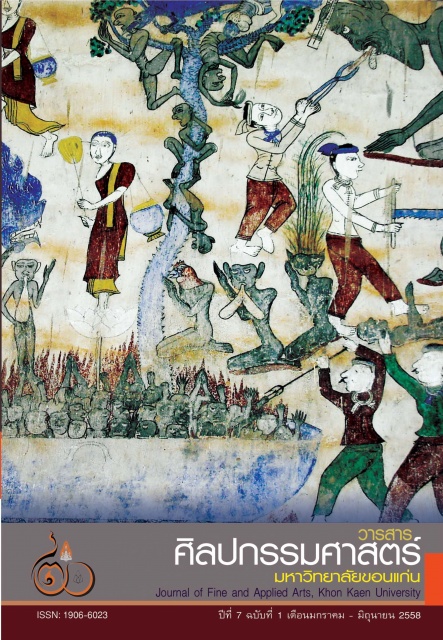วิธีการดำเนินทำนองของปี่ใน ในการบรรเลงเพลงหน้าพาทย์ขั้นสูง กรณีศึกษาเพลงพราหมณ์เข้า Methods of Performing Pii-Nai in the High-Level Naa Phaat Pieces : A case study of “Phrahm Khao”
Main Article Content
Abstract
การวิจัย เรื่อง วิธีการดำเนินทำนองของปี่ใน เพลงพราหมณ์เข้า มีวัตถุประสงค์ในการวิจัย เพื่อศึกษาประวัติ และโครงสร้างทำนองหลักเพลงพราหมณ์เข้า วิเคราะห์วิธีการดำเนินทำนองของปี่ใน เพลงพราหมณ์เข้า โดยใช้ระเบียบวิธีวิจัยเชิงคุณภาพ โดยการดำเนินการศึกษาข้อมูลจากเอกสาร ข้อมูลจากการสัมภาษณ์ และจากการปฏิบัติจริงแล้ววิเคราะห์เพื่อนำมาสรุปผลเป็นผลของการวิจัย
ผลจากการศึกษาพบว่า เพลงพราหมณ์เข้า เป็นเพลงหน้าพาทย์ชั้นสูงที่มีมาแต่โบราณใช้บรรเลงในพิธีไหว้ครูดนตรีไทย และนาฏศิลป์ไทย เพื่ออัญเชิญครูฤๅษีหรือนักพรตเข้ามาในมณฑลพิธี ในการแสดงใช้บรรเลงประกอบกิริยาเข้าไปในมณฑลพิธีของตัวละครพระ ยักษ์ผู้สูงศักดิ์ หรือผู้ทรงศีล พบปรากฏหลักฐานจากบทละครที่ใช้แสดงในสมัยรัชกาลที่ ๑ ลักษณะโครงสร้างทำนองหลักของเพลงพราหมณ์เข้า เป็นอัตราจังหวะ ๒ ชั้น มีจังหวะไม้กลอง ๒๐ ไม้เดิน ๔ ไม้ลา ออกรัวเฉพาะ การเคลื่อนที่ของทำนองเพลงอยู่ในบันไดเสียงทางใน ทางกลาง และทางกลางแหบ พบมากในบันไดเสียงทางใน
วิธีการดำเนินทำนองของปี่ใน ในเพลงพราหมณ์เข้า ใช้การดำเนินทำนองในช่วงเสียงต่ำ(ทางต้อ) ๕ เสียง โดยปรากฏการใช้เสียงที่ต่ำที่สุดของระบบเสียงปี่ใน ช่วงเสียงทางกลางครบทั้ง ๘ เสียง และช่วงเสียงทางแหบ ๒ เสียง ลักษณะในการดำเนินทำนองค่อนข้างช้า โดยใช้วิธีในการดำเนินทำนองดังนี้ ๑) ดำเนินทำนองแบบ“บังคับทาง” โดยยึดตามลักษณะอย่างทำนองหลัก ๒) ใช้วิธีการ “ตบแต่งทำนอง” เป็นสำนวนกลอนปี่ใน ๓) วิธีการดำเนินทำนองด้วย “การระบายลม” “การบังคับลม” ที่เป่าให้ถึงระดับเสียง ๔) การดำเนินทำนองด้วยวิธีการ“ดำเนินกลอน” “เป่าเก็บ” เป็นพยางค์ถี่ๆ ๕) ใช้กลวิธีในการประดิษฐ์เสียงปี่ใน ให้มีความไพเราะขึ้นด้วยวิธี ตอดลิ้นปี่เพื่อใช้เสียงปี่มีความชัดเจน พรมนิ้ว ควงเสียง การสะบัด และการตีนิ้ว
The aims of this research are to study the historical background and fundamental melodic structure of the high-level Naa Phaat piece, Phrahm Khao, as well as to analyse the performance methods of Pii-Nai in the Phrahm Khao piece based on a qualitative research methodology. The results of the study are as follows;
1. Phrahm Khao is one of the ancient high-level Naa Phaat pieces, performed during the momentous Wai Khru ceremonies in Thai Classical Music and Thai Dramatic Arts traditions. It accompanies the invocation of the spirits of hermit-teachers to attend the sacred ceremony. In Thai Khon masked drama, this piece is used for accompanying the movement of the hero, high-ranking devils and hermits crossing into the sacred area. The distinctive feature of Phrahm Khao is the fundamental structure of its main melody. This piece uses the Song Chan Thai metric level, which consists of twenty beats of Mai-Klong, four beats of Mai-Dearn, Mai-La, and Rua rhythmic patterns. The melodic structure of this piece is in the Nai, Klang, and Klang-hape scales, but it is found mostly in the Nai scale.
2. Analysis of the method of performing Pii-Nai in the Phrahm Khao piece reveals that the Pii-Nai melody appears in five pitches of the low octave (Toe), eight pitches of the middle octave (Klang) as well as two pitches of the high octave (Hape). The melodic movement of Pii-Nai is relatively slow. The method of performing the Pii-Nai for this piece can be separated into five aspects: following the main melody (Bungkabthang); ornamenting the main melody through a Pii-Nai melodic pattern; applying the circular breathing technique (Rabuylom); sounding continuous notes (Pao-Kep); using multiple techniques in tonguing (Tod-Lin), trilling (Phrom-Neui), alternative fingering (Neui-Kwoung), tripling (Sabut) and knocking (Tee-Neui).
Article Details
Content and information in articles published in the Journal of Fine and Applied Arts of Khon Kaen University is regarded as the opinion and sole responsibility of the author(s) directly; therefore, editors are not obliged to agree to or share any responsibility with regard to the content and information that appears within these articles.
All articles, information, content, image, etc. that have been published in the Journal of Fine and Applied Arts of Khon Kaen University is the copyright of the Journal of Fine and Appllied Arts of Khon Kaen University. Any person or organization who wishes to distribute all or parts of the articles for further dissemination or other usage must first receive permission from the Journal of Fine and Applied Arts of Khon Kaen University before proceeding to do so.


